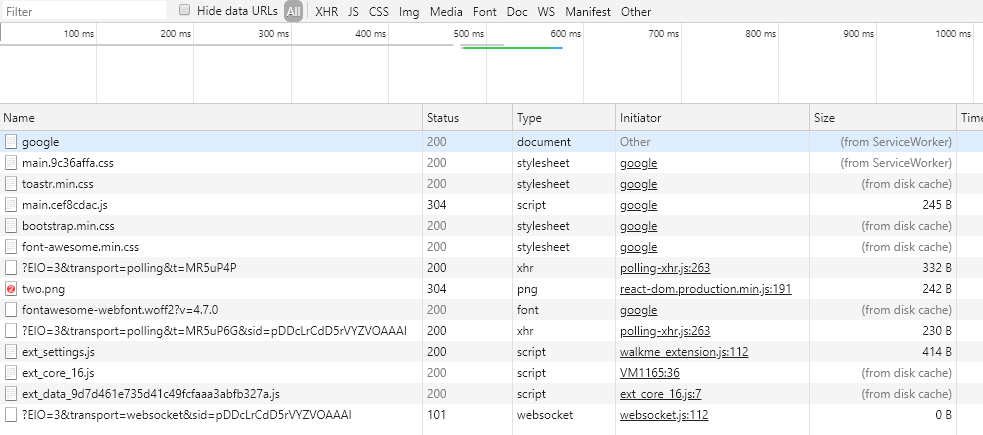I tried to add social login to my (already working) react/express app, and I got it working in localhost. However, when I deploy it to production, the social login doesn't work. This is how it gets started
<a href="/api/auth/google">Google+</a>
However, in production, it stays at https://sample.com/api/auth/google in my browser. So, it appears the react router is catching it first before express. How?
In localhost, it works because the proxy in package.js
"proxy": {
"/api": {
"target": "http://localhost:4000",
"ws": true
}
Now, how can I do this for production?
By the way, all my server APIs starts with '/api/...'. Also, in my react routes, I don't have a catch-all component.
UPDATE: Here is my server.js
var express = require('express');
var session = require('express-session');
var bodyParser = require('body-parser');
var flash = require('connect-flash');
var cookieParser = require('cookie-parser');
var path = require('path');
var fs = require('fs');
var app = express();
var isSecured = true;
app.isDevMode = app.get('env') == 'development'
require('./server/config/log')(app)
var port = (process.env.PORT || app.isDevMode) ? 4000 : (isSecured ? 443 : 80);
app.set('port', port);
app.use(bodyParser.urlencoded({ extended: true }));
app.use(bodyParser.json({ limit: '10mb' }));
app.use(flash()); // use connect-flash for flash messages stored in session
var server = require('http').createServer(app);
if (!app.isDevMode && isSecured) {
var options = {
ca: fs.readFileSync('ca_bundle.crt'),
key: fs.readFileSync('private.key'),
cert: fs.readFileSync('certificate.crt')
}
server = require('https').createServer(options, app);
}
db.on('error', console.error.bind(console, 'connection error:'));
db.once('open', function () {
console.log('Connected to MongoDB');
var routes = require('./server/routes');
routes.init(app);
if (app.isDevMode) {
app.use(express.static(__dirname));
}
else {
app.use(express.static(path.join(__dirname, 'client/build')));
app.get('/*', function (req, res) {
res.sendFile(path.join(__dirname, 'client/build', 'index.html'));
});
if (isSecured) {
require('http').createServer(function (req, res) {
res.writeHead(307, { "Location": "https://" + req.headers['host'] + req.url });
res.end();
}).listen(80);
}
}
server.listen(app.get('port'), function () {
console.log('Server listening on port ' + app.get('port'));
});
});
module.exports = app;
Here is my routes:
app.get('/api/auth/google', passport.authenticate('google', { scope: ['https://www.googleapis.com/auth/userinfo.profile', 'https://www.googleapis.com/auth/userinfo.email'] }))
app.get('/api/callback/google', passport.authenticate('google', {successRedirect: '/?action=login&provider=google', failureRedirect: '/?action=login'}))
UPDATE: Here is the morgan log. I added a number for each line for my reference. Line 4 started when I click the link to send '/api/auth/google', and finished at line 6.
1. GET /api/get/list?parm={%22kind%22:%22Prod%22,%22limit%22:5,%22createdOn%22:-1} 304 - - 22.959 ms
2. GET /images/logo.png 200 3432 - 17.410 ms
3. GET /service-worker.js 200 3097 - 3.398 ms
4. GET /static/js/main.cef8cdac.js 304 - - 5.180 ms
5. GET /images/two.png 304 - - 4.908 ms
6. GET /service-worker.js 200 3097 - 3.838 ms
So, basically, the request didn't come to express server. Actually, if I had a catch all route in react, I can see it's hitting there.
Here is the network log:


create-react-app? – Roisproxyworks: https://mcmap.net/q/1021185/-deploying-create-react-app-to-heroku-with-express-backend-returns-invalid-host-header-in-browser – Roisnpm i -S morganto your API dependencies. Then include it where you're defining yourexpressmiddlewares:app.use(morgan('tiny')). Now you should see requests being logged to your console when you make any requests to the API. First make sure everything works in development, then try in production. This will tell you exactly where the issue is -- bad request (possibly proxy related) or incorrect backend routing (this assumes you can monitor the production server via a terminal) – Roisdeveloper toolsand look at theNetworktab and make sure the subtabXHRorAllis selected (either one). Then trigger your request and it should show up in the tab. Hover over the request to see its destinationURL(ex:http://example.com/api/google). For example: i.imgur.com/cPIked9.png – Rois